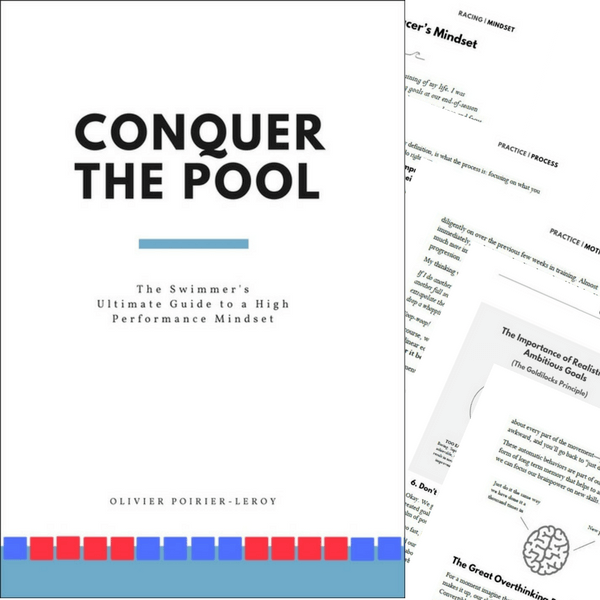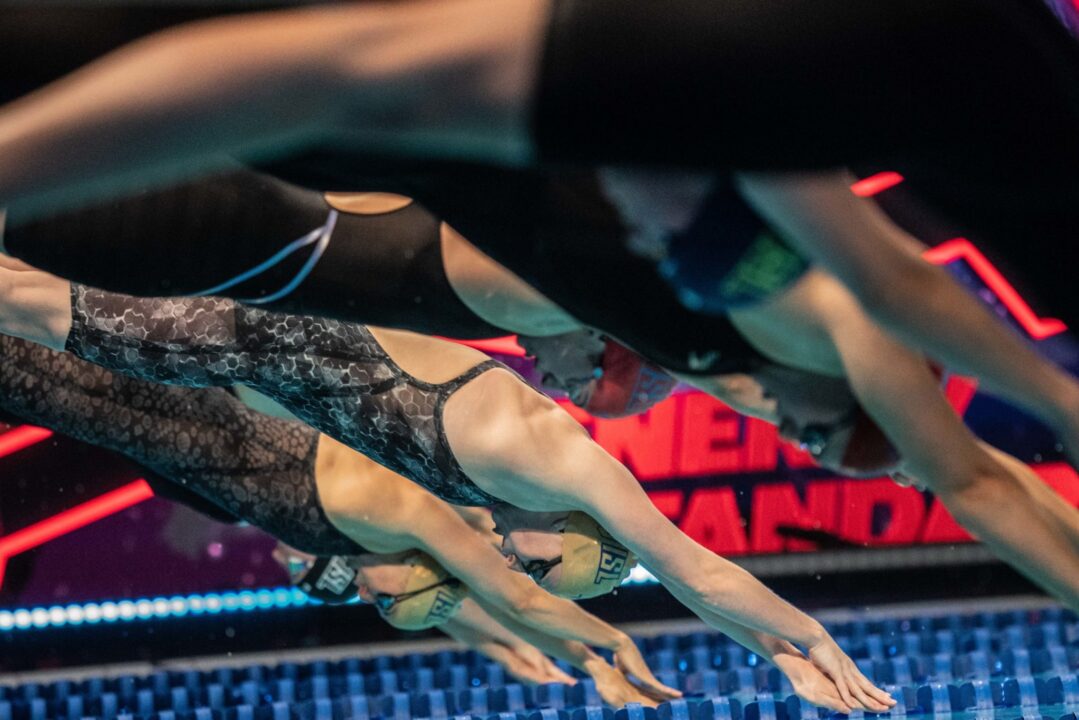Looking for more speed in the water? Here is how streamlining can help you swim faster and save energy and how to perfect your streamline.
A tight streamline in the water is crucial for reducing drag and maintaining speed in the pool.
Whether we are talking about the streamline when you dive into the pool or push off the wall, a perfect streamline helps you achieve faster speeds and conserve energy.
In this guide to streamlining like a boss in the water, we’ll cover everything you need to know about nailing a streamline in the water. We’ll also cover some research showing how much faster a tight streamline is, list some drills for improving streamline, and more.
Let’s dive in (with a perfect streamline, obviously!).
What is Streamline?
Streamlining is a body position and technique swimmers use to move through the water as efficiently as possible.
It’s a fundamental skill for competitive swimmers and is vital for maintaining peak speeds when diving into the water or pushing off the wall.
A fast streamline reduces resistance in the water and allows swimmers to surface at higher speeds, helping them swim faster.
What are the Benefits of a Good Streamline?
A good streamlined position offers several benefits, which are crucial for swimmers looking to maximize the hard work they do in practice.
Here are the key benefits of a strong streamline in the pool:
Cleaner dive entry.
During a swim race, the fastest you will ever move across the length of the pool is when you are flying off of the block and about to enter the water.
Having a tight streamline when entering the water allows you to hit the water with maximum speed.
Having your hands locked, arms firmly against the sides of your head, and chin tucked, mean swimmers enter the water cleanly and reduce the amount of velocity they leak when encountering the increased resistance of water.
Faster underwaters.
Races are won or lost on the underwater phase, whether it’s off the start or when you explode out of each turn.
When you consider that, in short course races, swimmers can spend up to 60% of the race beneath the water’s surface, it becomes evident how crucial it is to maintain a streamlined position while performing dolphin kicks.
Swimmers spend a lot of time trying to improve their underwater dolphin kick; a tight streamline helps maximize this hard work and reduces unnecessary drag.
More speed off the walls.
Swimmers hit peak speeds off the dives. Off the turn is the second fastest phase of a length of swimming.
From the time the feet push off from the wall or bulkhead, the water’s resistance causes swimmers’ velocity to steadily decline until they reach the wall and perform another turn.
A tight streamline helps to maximize the increased velocity and helps swimmers start each length with more speed.
Energy conservation.
Finally, a tight streamline reduces the amount of effort required to haul your chlorinated rear-end across the pool.
Swimmers devote a lot of time to getting stronger in the pool, whether that’s hitting the weight room or the full range of energy systems within the main sets.
A tighter streamline is “free” speed that doesn’t require any additional energy or work to generate.
- Fun Fact: A study published by the Journal of Human Kinetics analyzed the effects of different head positions when streamlining. Compared to the “head up” streamlined position, passive drag decreased by a whopping 4 to 5.2% when the head was tucked or aligned with the arms.
Faster swimming
A tight streamline is not only crucial for starts and turns, but also when swimming.
Breaststrokers spend around 20% of the stroke cycle in a glide position (Seifert et al., 2011). Another study published in the International Journal of Sports Medicine found similar patterns in the butterfly stroke.
A more streamlined position reduces hydrodynamic resistance, helping you swim faster.
How to Improve Your Streamline
Improving your streamline can be done in and out of the water with some drills, stretches, and performance cues.
Here are my favorite ways to tighten up the streamline for swimmers:
Streamline push-offs.
One of the easiest ways to get real-world feedback on how your streamline is performing is by pushing off in a streamline to see how far you can go. Don’t do any kicks; push off and see how much distance you can get.
This drill is also partly a reflection of how much leg power you can generate when pushing off, but you will be able to immediately see how much further you can go with a braced core, arms locked in place, and head properly tucked.
This drill is something every level of swimmer should perform regularly as a reminder to streamline like a boss.
A variation of this drill, also known as Dive and Glides, which also reinforces clean dive entry, is to do streamlines-for-distance from a swim start.
Caeleb Dressel demonstrates this in his Instagram post below.
Increase flexibility.
Proper streamlining requires a fair amount of flexibility. Stiff shoulders and lats can make it difficult to get into a tight streamline.
To hit that perfect streamline, try these two stretches for swimmers that will help increase the overhead range of motion:
Wall Angels
Wall angels are an overhead mobility exercise that helps to stretch out the chest, rotator cuffs, and lats.
- Standing against a wall (the stretch can also be done lying on the ground, too), bend the elbows to 90 degrees.
- Keeping the shoulders and back pinned against the wall, slide the arms up and see how close you can get to a streamlined position.
The wall angel stretch helps improve the range of motion for streamlining and is also one of my top stretches for better posture.
Lat Pulls
The latissimus dorsi pushes weight when it comes to swimming performance.
Those big, fan-shaped muscles generate shoulder stability and pulling power and, you guessed it, help us lock into a killer streamline when pushing off.
Lat pulls are a simple stretch that can be done just about anywhere.
- Grab something sturdy, around shoulder height.
- Hinge at the hips and let the rear end pull backward.
- Generating a nice stretch down the sides of the torso.
As you progress with this stretch, lean into the side being worked to increase the stretch.
Tight lats not only inhibit settling into a tight streamline when in the water but can also lead to tightness in the scaps, increasing the likelihood of injury (Kibler & Sciascia, 2010).
Improve core strength
Core strength is vital for swimmers for several reasons, including injury prevention, better stroke mechanics, and increased power.
And yes, core exercises for swimming can help you swim faster.
A study done with national-level swimmers found that a three-times-a-week core training program improved swimming performance in various ways, including faster velocity in the water, more explosive starts, and even faster flip turns (Karpinski et al., 2020).
A stronger core helps you generate a rigid and firm spine, especially in a streamlined position. Swimmers with a weak core tend to struggle to maintain proper streamlines as they fatigue.
You see it in the swimmer whose streamline looks like they are holding a beach ball overhead when tired.
Core exercises like planks, pot stirrers, and rollouts can help swimmers develop core strength (and overhead extension strength) to streamline firmly from the time they dive in the water at the beginning of swim practice until the main set wraps up.
Tuck your chin
Streamlining efficiently requires placing the head in line with the axis of the body. In other words, head tucked, chin pointing at the sternum.
A physical cue to establish a drag-busting streamline is tucking the chin into your chest when locking the arms in place overhead.
When the head is aligned with the body in this manner, the body provides less resistance when torpedoing across the pool.
A paper titled “Analysis of the effect of swimmer’s head position on swimming performance using computational fluid dynamics” found that when the head was aligned with the body, swimmers experienced a 20% decrease in drag at higher swimming velocities.
Tuck your chin to avoid creating unnecessary drag in the water.
Wrapping It Up
Improving swim performance can feel like a bit of a struggle and a mystery at times.
Countless hours and months of training to shave just a slice of time off of a personal best time.
Streamlining efficiently, however, is something you can do today to increase swimming performance.
With each push-off, each dive, and each start, reduce resistance and crank up the speed by locking in a slick streamline.
Tighten up that streamline, kick excess drag to the gutter, and take your swimming to new levels.
ABOUT OLIVIER POIRIER-LEROY
Olivier Poirier-Leroy is a former national-level swimmer. He’s the author of YourSwimBook, a ten-month logbook for competitive swimmers.
 He’s also the author of the recently published mental training workbook for competitive swimmers, Conquer the Pool: The Swimmer’s Ultimate Guide to a High-Performance Mindset.
He’s also the author of the recently published mental training workbook for competitive swimmers, Conquer the Pool: The Swimmer’s Ultimate Guide to a High-Performance Mindset.
It combines sport psychology research, worksheets, anecdotes, and examples of Olympians past and present to give swimmers everything they need to conquer the mental side of the sport.
Ready to take your mindset to the next level?
Click here to learn more about Conquer the Pool.

Very helpful- thank you for including simple (though not easy) exercises to improve.